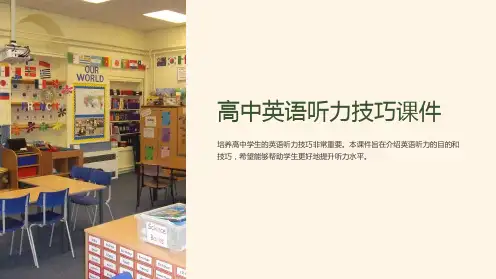• 3.听后:连贯记忆,前后联系,综合考虑, 一锤定音。
• 4.快速记录:
• 心记:这种能力对于解决听力第1节的问题非 常适用。
• 笔记:
• 1)运用速记符号例 如:↑up↓down←left→right=equal
• 2)发明并运用字母的缩写形式Ex—— expensive lg——large eq——earthquake
place? • (这段对话最可能发生在什么场合?)解这类试题时,
我们需要有一些积累和推断。 • 提示1:熟悉、积累常用地名,如国家、首都、大城
市、着名的标志性建筑以及山川河流的名称等 • 提示2:熟悉、积累与各个地点场所有关的单词、短
语、句型和场景。
• 如:
•
restaurant: menu, bill, order, tip, hamburger, beer, soup
them? • 3)When did they have the conversation? • 4)Where did the conversation take place? • 5)Why do they have the conversation? • 6)What did they plan to do?
•
airport: flight, take off, land, luggage
•
railway station :round trip, single trip, sleeping car
•
store: on sale, size, wear, color, style, price, change,bargain,
• 这类试题在高考听力试题中约占2小题,它要求我 们对听到的内容有一个整体的把握和全面的领会, 抓住说话者究竟在说什么。任何一段对话或独白 都是围绕一个中心展开的,有时主旨大意较明显, 有时则需要归纳、概括。常见的提问方式有:









![英语听力技巧与方法最新PPT课件[文字可编辑]](https://uimg.taocdn.com/1c8005ca02020740bf1e9b68.webp)
